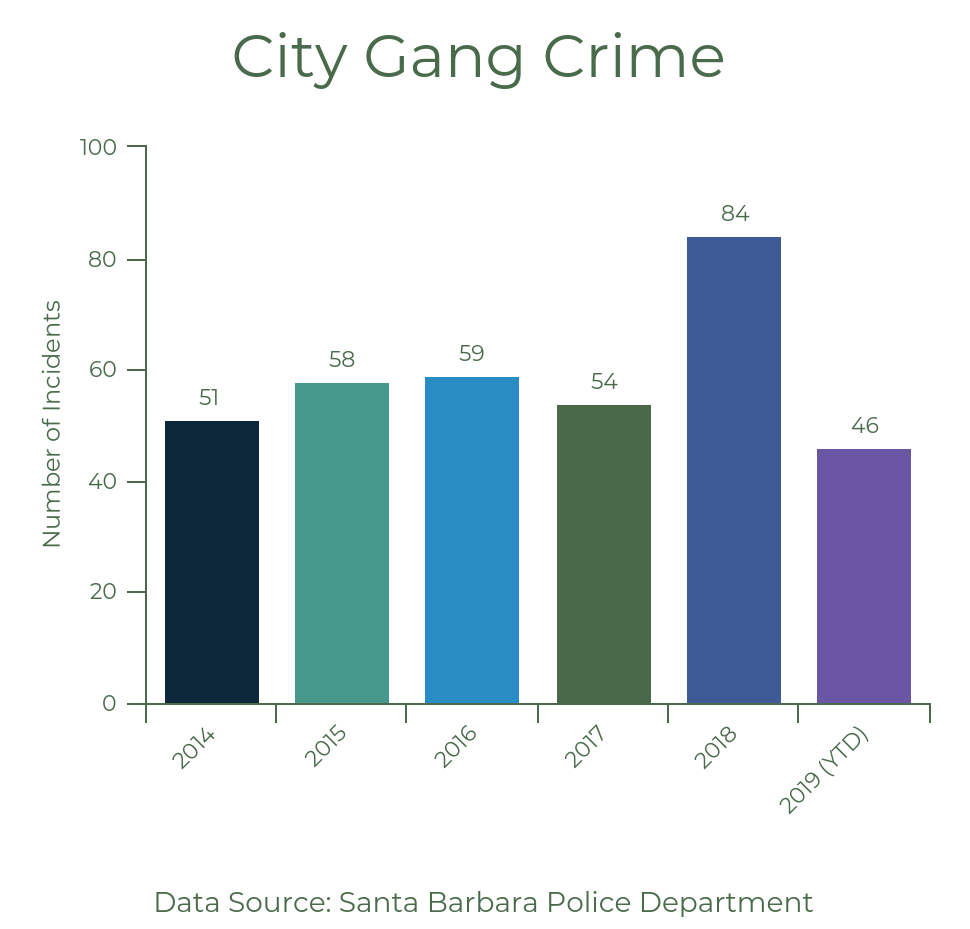Santa Barbara Gang Crime Is Up
Violent Incidents Have Been Spiking Since the Beginning of 2018

Gang crime in the City of Santa Barbara is up, with a noticeable spike in gang-fueled incidents between 2017 and 2018 and this year’s numbers on pace to be even higher. Not only are there more overall cases, authorities say, they’ve increased in violence and intensity.
This Monday, four alleged members of the Westside gang pleaded not guilty to the fatal June 1 stabbing of Alberto Torres on Cacique Street. A trial date has now been set for three men charged with the New Year’s Day murder of Jesus Reyes. And prosecutors are currently juggling multiple gun cases, recently securing the attempted murder conviction of a longtime Eastside gang member who fired on rivals. He was sentenced to 28 years in prison. “When you see cases involving gang members with guns, that’s concerning,” said Senior Deputy District Attorney Kimberly Siegel, who is now embroiled in a separate attempted murder trial of a well-known rapper and suspected gang member.
Siegel attributed the higher figures partially to a rise in incidents of gang members coming from outside the city and committing burglaries and robberies. She said suspects have driven from the Lompoc and Los Angeles areas to ransack Montecito homes left empty by the debris flow and target pharmacies stocked with prescription pills. Siegel also blamed recent reforms of the state’s justice system, including propositions 47 and 57, which allowed parole consideration for nonviolent felons and reduced certain drug charges, respectively.
But Siegel, along with the city police department’s Lieutenant Kenneth Kushner, mainly pointed to growing activity and tension among the city’s two main gang factions, the Eastside and Westside. While 2008’s regional crackdown on organized crime, called “Operation Gator Roll,” quieted things for many years, the power vacuum left by taking major players off the street is now being filled by groups of at-risk youth coming of age. Siegal said the aggression isn’t limited to gang-on-gang attacks. An Uber driver was recently assaulted, and residents in the Milpas area have been held up at gunpoint.
Kushner said it’s difficult to say what event or series of events may have precipitated the recent wave of intra-gang violence. “Retaliation and payback are part of that culture,” he said. “One incident could lead to another, and another, and another.” In response, police have stepped up patrols and probation searches. “We’ve done a few things we don’t typically do as a regular course of business,” he said. Even during recent staffing shortages, Kushner said, the department has been careful to maintain full funding for its anti-gang units. And its committed to ongoing preventative programs, including the Police Activities League (PAL), he said.
Mayor Cathy Murillo has been heavily involved in gang diversion efforts throughout her political career and took a significant amount of credit for the dip in activity during her time on the council. She said the current uptick isn’t necessarily surprising and shouldn’t be a cause for concern. “We knew there would be flare-ups, now matter how successful our prevention efforts, and I have full faith in our police department, probation, and service providers to keep focused on intervention when needed and suppression when required,” she said.
Central to that work is the South Coast Task Force on Youth Safety, said Murillo. Director Saul Serrano said the Task Force will continue coordinating with government and schools to guide students tempted by a life of crime toward healthier pursuits, and it’s now applying for a $1 million federal grant to bolster programs throughout the county, but especially in Santa Maria and Lompoc, where gang violence is growing at an even faster rate.
Serrano said it’s tragic to see youth he’s worked with take the wrong path. “We’ve provided them opportunities, but they’ve made their choice,” he said. Nevertheless, he’s also confident the numbers will decrease again. “We know it’s cyclical,” he said. “When they go down, we celebrate. And when they go up, we get to work.”



